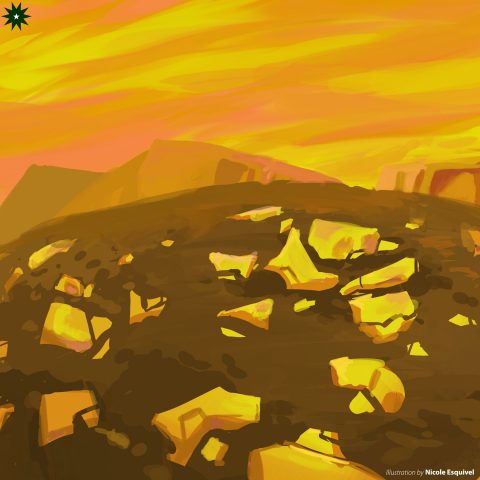“Basically, Venus is a hell-hole,” articulates Massachusetts Institute of Technology researcher William Bains as he describes the evening star in an interview with The LaSallian. While Venus is similar to the Earth when it comes to size and mass, a closer look shows that Venus does not possess the same life-giving qualities of Earth. The planet’s average surface temperature is around 460 degrees Celsius, which is hot enough to melt lead, tin, and zinc. Since its atmosphere is ten times drier than the driest place on Earth, its clouds are made of concentrated sulfuric acid. Given all that, it would seem to be an unlikely place for life to develop.
“If you wanted to completely kill off a sample of Earth life, you could cook it to 460 degrees Celsius, or completely dessicate it, or cook it up in 80 percent acid. And Venus does all three,“ Bains explains.
Last September 14, however, a group of researchers, of which Bains is part of, reported the detection of the chemical phosphine in the Venusian atmosphere. An extremely important discovery as the concentration of phosphine found in Venus’ atmosphere makes it a possible biomarker, pointing to signs of life. While its presence cannot currently be explained through non-biological means, its detection is a glimmer of light for the once-impossible notion of life on Venus.
As with science however, there is still a need for verification. Scientists have scrutinized the data behind the discovery and doubts have been casted on the amount of phosphine in the planet’s atmosphere. The question scientists are more interested in raising at this time is not “Is there life on Venus?” but “Is there even phosphine on Venus?”
Life on Venus?
Made up of one phosphorus atom and three hydrogen atoms, phosphine is an odorless and colorless gas commonly found in Jupiter and Saturn’s atmospheres, primarily due to the abundance of hydrogen. Phosphine, however, is a rarity on terrestrial planets. On Earth, it is only made by bacteria in oxygen-free environments and by humans for industrial purposes. “So the only reason that there is any phosphine in the atmosphere of Earth is because there is life on Earth,” Bains remarks.
Using two telescopes, Hawaii’s James Clerk Maxwell Telescope and Chile’s Atacama Large Millimeter Array (ALMA), researchers have discovered considerable amounts of phosphine in the atmosphere of Venus that should not have been possible, given the known chemistry processes of the planet. “We went through every type of chemistry we could think of—reactions between the gases of the atmosphere, the gases and the surface rocks, the gases and the cloud drops, between rocks below the surface. We studied whether lightning could make it, or meteorites falling from space. None of these explained the presence of phosphine,” Bains explains.
However, even if there is a lack of non-biological explanations for the presence of phosphine in Venus, this does not guarantee that life does exist on Venus, as the phosphine may have been created by chemical processes yet to be discovered. “Almost nothing is known about what the Ultraviolet light in sunlight does to the sulfuric acid in the clouds,” says Bains, citing one possible other chemical source of phosphine.

Shadows of doubt
The findings are not without their critics. John M. Carpenter, a scientist fromat the ALMA Observatory who was involved in collecting data on for the original study expressed concern over the validity of the findings as he was not involved in analyzing the data.
Another researcher involved in the original study, Clara Sousa-Silva, who participated in a subsequent reanalysis of data collected from Venus since 2012 in a Speaking about this second study, led by Therese Encrenaz from the Paris Observatory, she says, “I believe Encrenaz’s work, and so there’s no phosphine—there. It’s just, where is this there?”, citing that the claim, at least for now, is neither right nor wrong.
Encrenaz’ study suggests that the quantity of phosphine on Venus may be, at most, four times lower than what Greaves’ study reported. “At the level of the cloud tops, there is no [phosphine] at all,” says Encrenaz. “It’s completely premature to talk about life. Even if it had been demonstrated that phosphine is present, you could not just jump and say that this is because of life.”
Meanwhile, Martin Cordiner, an astrochemist at NASA’s Goddard Space Flight Center, provides a possible explanation for the discrepancies. The data used to infer phosphine’s presence, made from the observation of specific wavelengths of light from Venus, may have been affected by interference from anywhere between the telescope used and Venus’ atmosphere.
Venus’ intrinsic brightness may also be a source of interference. “You could think of it as being dazzled by a bright light,” says Cordiner. “If there’s a bright light in your vision, then your ability to pick out fainter details becomes diminished.”
He adds that the equation Greaves used to filter out this interference may also have been too blunt, removing more noise than necessary and leaving false signals. This is corroborated by a study led by Ignas Snellen, an astrophysicist from Leiden University. His team used the same noise filtering meth-ods used by Greaves on other parts of Venus’ spectrum and found signals for molecules that were not really there.
Calls for Greaves and her team to retract their paper have emerged, but the paper remains in publication. Sousa-Silva welcomes the criticism, saying that having concerns regarding the validity of the study “is completely normal and what I expected (nay, hoped) would happen. This is usually a phase of a project that I enjoy, and I am hoping people will realize this is just what science looks like.” Indeed, subsequent studies that challenge their original findings only serve to expand the body of knowledge about Venus. The idea of finally finding extraterrestrial life is exciting, but in science, the pursuit for truth comes first.
